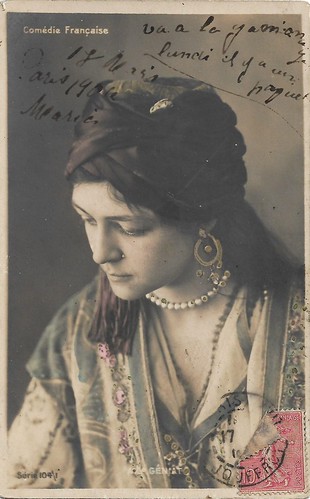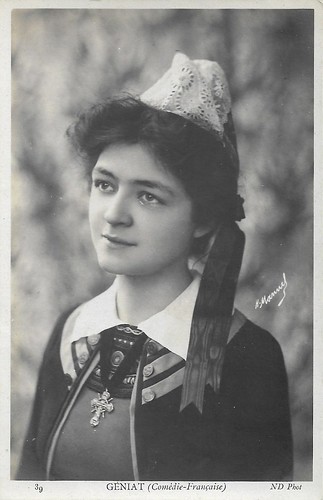French stage and screen actress Marcelle Géniat (1881-1959) was a Sociétaire of the Comédie-Française. She also appeared in fifty-three films between 1909 and 1956.

French postcard, series 104-1. Caption: Marcelle Géniat, Comédie Française.

French postcard by ND Phot., no. 39. Photo: Henri Manuel. Caption: Géniat (Comédie-Française).

French postcard. Photo: Paul Boyer, Paris. Stamp dated 1905.
Marcelle Géniat was born Eugénie Pauline Martin in Saint Petersburg, Russian Empire, in 1881. Her parents were French. Very young, Géniat started her career at the theatre. At the age of eight, she already played in Emile Zola's 'L'Assommoir' in Saint Petersburg, alongside Lucien Guitry. Later she attended dance classes.
Back in Paris, she entered the Conservatory of Dramatic Art in 1899 in the Leloir class. After obtaining the first prize in comedy at the Conservatory, she entered the Comédie-Française in 1899. She learned the trade by playing classics like 'Les femmes savantes' by Molière, and 'Andromaque' by Racine, as well as boulevard plays like 'La petite amie' by Eugène Brieux or 'Bagatelle' by Paul Hervieu.
She was very successful in the roles of Aricie in 'Phèdre' and Atalide in 'Bajazet'. She also played in contemporary theatre, such as 'Paraître' by Maurice Donnay, 'Les Fresnay' by Vandérem, 'L'Amour vigil' by de Flers and Caillavet, and 'The Wonderful Flower' by Miguel Zamacoïs.
She also interpreted the heroines of Alexandre Dumas fils, Paul Hervieu, Édouard Pailleron, and Octave Mirbeau. She became a Sociétaire (a member) in 1910 and left the Comédie Française in 1912.
During the First World War, Marcelle Géniat became a nurse and devoted her care to the wounded. After the war, she made a great career on the boulevards. Her best-known role was as Mademoiselle in the play by Jacques Deval. In the 1930s, in addition to being an actress, Géniat was also the director of a correctional centre for girls in Boulogne-Billancourt.

French postcard by FC & Cie, no. 86/2. Photo: A. Bert. Marcelle Géniat in 'Le Roi s'amuse'.

French postcard by Procédés G. Jeangette. Photo: Oricelly. Caption: Marcelle Géniat de la Comédie-Française in 'Oedipe Roi' (Oedipus Rex) by Sophocles. Sophocles' classic tragedy was part of the regular repertory of the Comédie-Française. In 1908 Géniat acted in it in a supporting part, while Mounet-Sully played the title role, and Jocaste was alternatingly acted by Jeanne Delvair and Louise Silvain.

French postcard by Procédés G. Jeangette. Photo: Oricelly. Caption: Marcelle Géniat de la Comédie-Française in 'Oedipe Roi' (Oedipus Rex) by Sophocles.
In the cinema, Marcelle Géniat appeared in fifty-three films between 1909 and 1956. She made her film debut for Pathé Frères in Le roi s'amuse/The king has fun (Albert Capellani, Michel Carré, 1909) with Henri Sylvain. It was followed by another short film for Pathé, Rigoletto (André Calmettes, 1909), starring Paul Mounet. During the 1910s, she played in four films. These included two films by actor and director Léonce Perret: L’imprévu/The Unexpected (1916) with Henry Roussel, and Le retour du passé/The Return of the Past (1916).
Her largest cinema output was in the French sound films of the 1930s and 1940s. Géniat often played afflicted women such as in La fusée/Grandeur and Decadence (Jacques Nathanson, 1933) with Firmin Gémier. She had the lead in La joueuse d'orgue/The Organ Player (Gaston Roudès, 1936), an adaptation of a classic novel by Xavier de Montepin which had already been filmed in 1925. The film deals with a woman who witnessed a crime and became blind because of it.
Géniat also had major parts as La Chouette in the drama Les mystères de Paris/The Mysteries of Paris (Félix Gandéra, 1935) with Lucien Baroux and Madeleine Ozeray, and as the mother of Raimu in L'étrange Monsieur Victor/The Strange Monsieur Victor (Jean Grémillon, 1938).
Her best years in the cinema took place during the occupation between 1940 and 1944 when she appeared in 10 films. These included the Horror film Le loup des Malveneur/The Wolf of the Malveneurs (Guillaume Radot, 1942), with Madeleine Sologne and Pierre Renoir, and Le voile bleu/The Blue Veil (Jean Stelli, 1942), with Gaby Morlay. She also appeared in one of the rare Pétainist films, Haut le vent/High the Wind (Jacques de Baroncelli, 1942), with Charles Vanel.
During this period, she also obtained her best screen role as Mamouret in Le briseur de chaînes/Chain Breaker (Jacques Daniel-Norman, 1941) opposite Pierre Fresnay. Daniel Chocron at CinéArtistes: "It is also the only time that Marcelle Géniat is the star of a popular film with a substantial budget and distribution, composing a character of anthology with a grumpy air attached to the small pleasures of life but lucid on the darkness of human nature." Marcelle Géniat died of cancer in 1959 in L'Hay-les-Roses, France. She was 78. She was buried in the Parisian cemetery of Saint-Ouen (Seine-Saint-Denis). Géniat was married to Paul Martel de la Chesnaye. They had a daughter, actress Gilberte Géniat.

French postcard by SIP, no. 1305. Photo: Paul Boyer, Paris. Caption: Géniat, Comédie-Française.

French postcard by WS Paris, no. 0515

French postcard in the 'Nos artistes dans leur loge' series, no. 304. Photo: Comoedia, Paris.

French postcard. Photo: Studio Carlet Ainé. Collection: Claude-Pascal Perna @ Flickr.
Sources: Comédie-Française (French), Wikipedia (English and French), and IMDb.
This post was last updated on 12 May 2024.

French postcard, series 104-1. Caption: Marcelle Géniat, Comédie Française.

French postcard by ND Phot., no. 39. Photo: Henri Manuel. Caption: Géniat (Comédie-Française).

French postcard. Photo: Paul Boyer, Paris. Stamp dated 1905.
Director of a correctional centre for girls
Marcelle Géniat was born Eugénie Pauline Martin in Saint Petersburg, Russian Empire, in 1881. Her parents were French. Very young, Géniat started her career at the theatre. At the age of eight, she already played in Emile Zola's 'L'Assommoir' in Saint Petersburg, alongside Lucien Guitry. Later she attended dance classes.
Back in Paris, she entered the Conservatory of Dramatic Art in 1899 in the Leloir class. After obtaining the first prize in comedy at the Conservatory, she entered the Comédie-Française in 1899. She learned the trade by playing classics like 'Les femmes savantes' by Molière, and 'Andromaque' by Racine, as well as boulevard plays like 'La petite amie' by Eugène Brieux or 'Bagatelle' by Paul Hervieu.
She was very successful in the roles of Aricie in 'Phèdre' and Atalide in 'Bajazet'. She also played in contemporary theatre, such as 'Paraître' by Maurice Donnay, 'Les Fresnay' by Vandérem, 'L'Amour vigil' by de Flers and Caillavet, and 'The Wonderful Flower' by Miguel Zamacoïs.
She also interpreted the heroines of Alexandre Dumas fils, Paul Hervieu, Édouard Pailleron, and Octave Mirbeau. She became a Sociétaire (a member) in 1910 and left the Comédie Française in 1912.
During the First World War, Marcelle Géniat became a nurse and devoted her care to the wounded. After the war, she made a great career on the boulevards. Her best-known role was as Mademoiselle in the play by Jacques Deval. In the 1930s, in addition to being an actress, Géniat was also the director of a correctional centre for girls in Boulogne-Billancourt.

French postcard by FC & Cie, no. 86/2. Photo: A. Bert. Marcelle Géniat in 'Le Roi s'amuse'.

French postcard by Procédés G. Jeangette. Photo: Oricelly. Caption: Marcelle Géniat de la Comédie-Française in 'Oedipe Roi' (Oedipus Rex) by Sophocles. Sophocles' classic tragedy was part of the regular repertory of the Comédie-Française. In 1908 Géniat acted in it in a supporting part, while Mounet-Sully played the title role, and Jocaste was alternatingly acted by Jeanne Delvair and Louise Silvain.

French postcard by Procédés G. Jeangette. Photo: Oricelly. Caption: Marcelle Géniat de la Comédie-Française in 'Oedipe Roi' (Oedipus Rex) by Sophocles.
Becoming blind after witnessing a crime
In the cinema, Marcelle Géniat appeared in fifty-three films between 1909 and 1956. She made her film debut for Pathé Frères in Le roi s'amuse/The king has fun (Albert Capellani, Michel Carré, 1909) with Henri Sylvain. It was followed by another short film for Pathé, Rigoletto (André Calmettes, 1909), starring Paul Mounet. During the 1910s, she played in four films. These included two films by actor and director Léonce Perret: L’imprévu/The Unexpected (1916) with Henry Roussel, and Le retour du passé/The Return of the Past (1916).
Her largest cinema output was in the French sound films of the 1930s and 1940s. Géniat often played afflicted women such as in La fusée/Grandeur and Decadence (Jacques Nathanson, 1933) with Firmin Gémier. She had the lead in La joueuse d'orgue/The Organ Player (Gaston Roudès, 1936), an adaptation of a classic novel by Xavier de Montepin which had already been filmed in 1925. The film deals with a woman who witnessed a crime and became blind because of it.
Géniat also had major parts as La Chouette in the drama Les mystères de Paris/The Mysteries of Paris (Félix Gandéra, 1935) with Lucien Baroux and Madeleine Ozeray, and as the mother of Raimu in L'étrange Monsieur Victor/The Strange Monsieur Victor (Jean Grémillon, 1938).
Her best years in the cinema took place during the occupation between 1940 and 1944 when she appeared in 10 films. These included the Horror film Le loup des Malveneur/The Wolf of the Malveneurs (Guillaume Radot, 1942), with Madeleine Sologne and Pierre Renoir, and Le voile bleu/The Blue Veil (Jean Stelli, 1942), with Gaby Morlay. She also appeared in one of the rare Pétainist films, Haut le vent/High the Wind (Jacques de Baroncelli, 1942), with Charles Vanel.
During this period, she also obtained her best screen role as Mamouret in Le briseur de chaînes/Chain Breaker (Jacques Daniel-Norman, 1941) opposite Pierre Fresnay. Daniel Chocron at CinéArtistes: "It is also the only time that Marcelle Géniat is the star of a popular film with a substantial budget and distribution, composing a character of anthology with a grumpy air attached to the small pleasures of life but lucid on the darkness of human nature." Marcelle Géniat died of cancer in 1959 in L'Hay-les-Roses, France. She was 78. She was buried in the Parisian cemetery of Saint-Ouen (Seine-Saint-Denis). Géniat was married to Paul Martel de la Chesnaye. They had a daughter, actress Gilberte Géniat.

French postcard by SIP, no. 1305. Photo: Paul Boyer, Paris. Caption: Géniat, Comédie-Française.

French postcard by WS Paris, no. 0515

French postcard in the 'Nos artistes dans leur loge' series, no. 304. Photo: Comoedia, Paris.

French postcard. Photo: Studio Carlet Ainé. Collection: Claude-Pascal Perna @ Flickr.
Sources: Comédie-Française (French), Wikipedia (English and French), and IMDb.
This post was last updated on 12 May 2024.
No comments:
Post a Comment